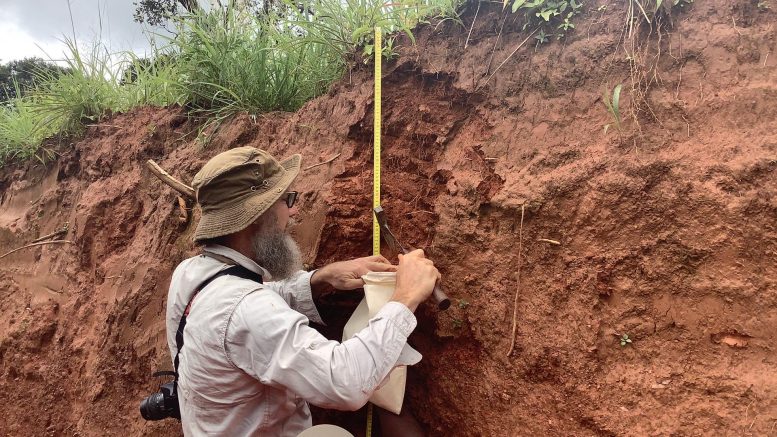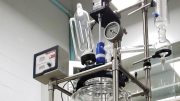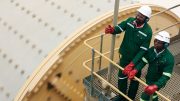KoBold Metals is investing in battery metal projects using big data and scientific computing with capital from billionaires including Bill Gates and Jeff Bezos.
The privately held California-based company has also lured David Broughton, the world-renowned expert in sediment-hosted copper deposits, to lead its hydrothermal systems team, and hired a number of other very high-profile geoscientists.
“David is very substantially involved,” Josh Goldman, KoBold Metals’ chief financial and technical officer, says of Broughton in a telephone interview.
Broughton worked for Ivanplats, now Ivanhoe Mines (TSX: IVN; NYSE: IVN), from January 2008 through October 2016, and was co-awarded the PDAC’s Thayer Lindsley and AME’s Colin Spence awards for world-class discoveries at Kamoa in the Democratic Republic of the Congo and Platreef in South Africa.
Goldman, who holds a PhD in physics from Harvard University, explains that the exploration company is a “little bit unusual in that more than half of the staff are data scientists and engineers.” On the technology side of the house, he says, “they are folks with deep backgrounds in the physical sciences, people with PhDs in physics, geophysics, and experimental quantum computing.”
“It’s fantastic because we have these amazing data scientists who get to work with very well-esteemed geological scientists and can understand the interplay and apply all manner of statistical methodologies, and lots of experience in the field. A lot of this is difficult to quantify, but that combined is what makes this program so potent.”
Among the team are Jake Edman, director of machine learning, a data scientist and atmospheric physicist who has a PhD in earth and planetary science, and Murray Hitzman, who has a PhD in geology and is a world-leading economic geologist. Jessica Kirkpatrick, who earned a PhD in astrophysics, and Elizabeth Main, who has a PhD in physics, are directors of data science.
Other luminaries include John Thompson, a technical and business advisor, who has a PhD in geology and has spent more than 35 years in the mining industry, and KoBold’s VP Exploration, Patrick Redmond, who has a PhD in geological and environmental sciences. Peter Lightfoot, the company’s magmatic systems lead, has a PhD in geology and spent 20 years with Inco and Vale. He was a member of the team that made major discoveries in every one of the cobalt-producing nickel-copper sulphide deposits in Canada.
“What it comes down to is having a system that allows us to aggregate and work with an extra amount of data and then apply machine learning as well as expert geological insight, based on an ore body, and apply the best of both approaches to guide our exploration program.”
It also comes down to patient capital. The exploration startup is backed by California venture capital firm Andreesen Horowitz, as well as Breakthrough Energy Ventures, a fund set up by Bill Gates in 2015 with money from a coalition of private investors, including Amazon founder Jeff Bezos and Virgin Group founder Richard Branson. Norway’s state-backed energy company Equinor recently took a stake in the company to get additional expertise in its hunt for oil and gas.
“We want to put great capital to work in great projects,” says Goldman.
KoBold’s primary focus is hunting for cobalt deposits and has staked claims in northeastern Saskatchewan up to the province’s border with the Northwest Territories.
“The one in Saskatchewan is very greenfield – it’s a potential new camp – but it’s very unconstrained,” he says.
“The other one we have in the public domain is in a historic camp where we think there’s a tonne of additional exploration potential. It’s a very large, established camp in Canada.”
The asset, which covers about 1,000 sq. km, is in the Cape Smith belt of northern Quebec, just south of Glencore‘s (LSE: GLEN) Raglan mine and the Expo-Ungava property being developed by Canadian Royalties and Jilin Jien Nickel. The company plans to start collecting geophysical data over the next six months to zero in on the area’s cobalt, nickel and PGM potential.
“The company’s Machine Prospector technology identified highly prospective areas for nickel-cobalt sulfide mineralization in the Cape Smith belt, a world-class nickel district with regions that remain significantly underexplored,” Goldman says. “KoBold’s prospects emerged from statistical models that relied on digitizing and integrating the patchwork of geologic mapping and geophysical and geochemical measurements collected over decades of exploration in the camp.”
Goldman declines to identify any of the company’s other properties or provide any details on them, but says it is applying its technology to identify prospective areas in greenfield or brownfield sites.
KoBold looks at greenfields opportunities on concepts it generates; it acquires properties from other companies; and it also strikes partnerships with companies on specific projects that have useful data. “We make the asset more valuable by adding technology to it, so the likelihood of finding greater resources is higher.”
“Some of them are brownfield opportunities where there is an existing resource and we’re looking to expand the resource, and others where there’s a whole range of conceptual targets, some of which are totally untested, and some of which have had initial tests.”
Then there are regional partnerships where there is data over a much larger area – not just data on a project that its partner owns.
Even some of the industry’s larger mining companies are “excited about potentially working with us,” he says.
“We have to use data better, and we have to be more efficient and effective in deploying our exploration capital,” Goldman explains. “But doing it is really hard. The data is very messy, and we’re looking for fainter signals in this. Exploration under cover – finding a 100 million tonne outcropping ore project is not the dominant exploration project now, and everyone in the industry is trying to figure out how to do this, so both large and small companies like us. All the large mining companies have leverage to do this, but there are so many opportunities out there.”
In addition to cobalt, the company is interested in nickel and is looking to have access to other metals as co-deposit credits.
“Copper is not a cathode metal, but as a co-deposit with cobalt and nickel, we’re interested in copper as well,” he says.
Goldman confirms that lithium is of interest but says it’s a lower priority, and KoBold Metals does not currently have any in its portfolio.
“There is so much of it, it’s harder” he says. “Lithium is only interesting if you have tenth lower production costs … We have ideas of finding high-quality lithium resources, but we haven’t put as much effort into looking for it.”
He also emphasizes that KoBold Metals has no desire to become a mining company and expects to take projects up the value curve only as far as a decision to mine and then another party will hold a majority interest.
In terms of jurisdictions, the company “will go anywhere in the world minus a few jurisdictions with difficult security of tenure, or which are large and difficult places to operate, or which are corrupt … certainly not Russia, for example.”
“We’re looking at resources of battery metals that can be produced ethically, so jurisdictions where there’s good rule of law and where we’re confident we can operate in.”
When asked if the Democratic Republic of the Congo is off limits, he replies: “It’s not a high priority jurisdiction for us – it’s a more challenging place to operate and we’re looking to develop battery metal resources that are not dependent on the DRC, so you won’t see us acquiring properties there anytime soon.”
The management team also gives a lot of weight to security, making countries such as Burkina Faso, Mali and Cote d’Ivoire in West Africa questionable. “Those jurisdictions are not totally off-limits. They are possible, but the above-ground component of the opportunity area is always a condition and that would be obviously true of West Africa, but it’s not totally off-bounds for us.”
As for the Covid-19 pandemic, it hasn’t slowed the company down too much, Goldman says.
“There’s a lot that can be done at desktop, and we’ve identified lots of properties and we’re working on them,” he says. “We continue to add to our portfolio through the Covid crisis. Transactions are still happening, so it’s full steam ahead.”






Be the first to comment on "KoBold Metals employs big data, geoscientists in pursuit of battery metals"